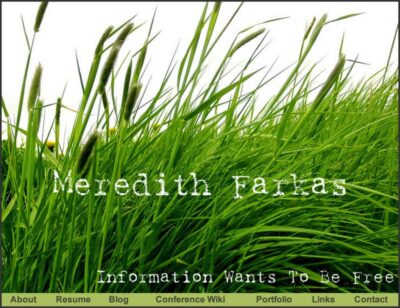Tom Ipri, La Salle University
At Computers in Libraries in March, I had told Tom how excited I was about going to his talk and then I promptly went and missed it by having a way too long lunch. D’oh! So I gave him my solemn word that I would come and see him give his talk at Internet Librarian, come hell or high water (unless his talk was at the same time as mine). Portals are really interesting to me, since I know that at my library we provide very different services to different populations. Our distance learners don’t even use the same site as the on-campus students – I created a library portal for them within WebCT. And since I am soon going to be undertaking a redesign of my own library’s Website, I was really interested in looking at how libraries are providing targetting information to patrons through portals.
Tom says that people’s conceptions of what a library Website should be/do are changing.
Tom works at LaSalle University which has 6200 students and 9 librarians, so there is no dedicated Web or portal librarian. Tom does a bit of everything.
They use Luminis/Campus Pipeline University-wide which went live summer 2003 under the name MyLaSalle. As soon as a student gets a student ID, they have a role in the portal and they will have different roles throughout their life. After they graduate, they will have a role in the portal as an alum.
Why put the library into MyLasalle? The library is the largest source of info on campus. The portal is the best opportunity to direct targeted information to specific populations. Students use e-mail, get grades, register for classes, etc. in the portal, so it makes sense to have a library presence in there.
Brief history: Tom was part of the development committee (the provost insisted that the library be represented on the committee). They wanted to ensure a library presence in MyLasalle. Originally, they just had a cheesy tab that had links out to the regular Website. They had a presence, but it wasn’t targeted to different groups and was kind of a dumbed-down version of the home page. In 2004, they hired a Director of Portal Communications, which meant that there was a single person dedicated to organizing and developing content in the portal. Their second version of the library presence in the portal. They had targeted announcements for different groups. Under MyAnnouncements, they could have announcements go only to people in specific groups.
They then got rid of the library tab and then had a myConnellyLibrary channel. In there, they aggregated different content into the channel. They use PHP scripts that aggregate XML content. Some content is hard-coded (static stuff).
To customize things further, they have a myResources channel, which aggregates information from the subject guide in that area as well as area news and external links for people in that subject.
New Developments: Added assignment calculator from the University of Minnesota. Using RSS feeds. Implementing a federated search engine. Upgrading to WebPac Pro.
They use RSS feeds for library news, databases, electronic journals, library links, etc.
Snags: Director of Portal Communication left and now development is uncertain. There is a new Web team, but the library now has to give permission for any changes to the portal (this sounds very familiar).
Now their portal is really targeted for students in different areas. And students can pick and choose the channels that they find useful to them.
What’s next: Single sign-on for portal and databases. Federated search. Upgrade to WebPAC Pro which involves the ability to extract RSS feeds, so they can generate things like new books lists. More use of CSS to tweak the look.
At my school, we purchased Luminis way before I got here and have more or less abandoned it (we’re using their previous product — ugh!). I’m not 100% sure why we never moved over to Luminis, but it sounded like a disaster on the IT side of things. It’s neat to see how you can push different pieces of content to different patron groups using portal software. I think this is a great use of portal software since, more often than not, academic portals are not used to really target services to the user and deliver targeted content. Nicole Engard commented during the session that Drexel uses Luminis as well for their portal and, as a student, she finds it difficult to find the information she needs and they don’t target content properly to the users. Nice work, Tom, in making the most of the capabilities of portal software to serve your patron groups! 🙂




Thanks for coming to my presenation. I hope it was worth the wait! Sorry I missed your RSS & Javascript presentation but it was right after my presentation and I needed to unwind.